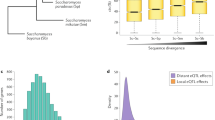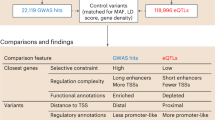Abstract
The genetic basis of variation in gene expression lends itself to investigation by microarrays. For genetic analysis, we view the expression level of a gene as a quantitative or 'complex' trait, analogous to an individual's height or cholesterol level, and, therefore, as an inherited phenotype. Several genetic analyses of 'gene expression phenotypes' have been carried out in experimental organisms, and initial steps have been taken toward similar studies in humans—although these present challenging technical and statistical problems. Further advances in the genetic analysis of variation in gene expression will contribute to our understanding of transcriptional regulation and will provide models for studying other quantitative and complex traits.
This is a preview of subscription content, access via your institution
Access options
Subscribe to this journal
Receive 12 print issues and online access
$209.00 per year
only $17.42 per issue
Buy this article
- Purchase on Springer Link
- Instant access to full article PDF
Prices may be subject to local taxes which are calculated during checkout

Katie Ris
Similar content being viewed by others
References
Brem, R.B., Yvert, G., Clinton, R. & Kruglyak, L. Genetic dissection of transcriptional regulation in budding yeast. Science 296, 752–755 (2002).
Cavalieri, D., Townsend, J.P. & Hartl, D.L. Manifold anomalies in gene expression in a vineyard isolate of Saccharomyces cerevisiae revealed by DNA microarray analysis. Proc. Natl Acad. Sci. USA 97, 12369–12374 (2000).
Steinmetz, L.M. et al. Dissecting the architecture of a quantitative trait locus in yeast. Nature 416, 326–330 (2002).
Jin, W. et al. The contributions of sex, genotype and age to transcriptional variance in Drosophila melanogaster. Nature Genet. 29, 389–395 (2001).
Sandberg, R. et al. Regional and strain-specific gene expression mapping in the adult mouse brain. Proc. Natl Acad. Sci. USA 97, 11038–11043 (2000).
Oleksiak, M.F., Churchill, G.A. & Crawford, D.L. Variation in gene expression within and among natural populations. Nature Genet. 32, 261–266 (2002).
Enard, W. et al. Intra- and interspecific variation in primate gene expression patterns. Science 296, 340–343 (2002).
Watts, J.A. et al. Gene expression phenotype in heterozygous carriers of ataxia telangiectasia. Am. J. Hum. Genet. 71, 791–800 (2002).
Concannon, P. ATM heterozygosity and cancer risk. Nature Genet. 32, 89–90 (2002).
Spring, K. et al. Mice heterozygous for mutation in Atm, the gene involved in ataxia-telangiectasia, have heightened susceptibility to cancer. Nature Genet. 32, 185–190 (2002).
Cargill, M. et al. Characterization of single-nucleotide polymorphisms in coding regions of human genes. Nature Genet. 22, 231–238 (1999).
Halushka, M.K. et al. Patterns of single-nucleotide polymorphisms in candidate genes for blood-pressure homeostasis. Nature Genet. 22, 239–247 (1999).
Kruglyak, L. & Nickerson, D. Variation is the spice of life. Nature Genet. 27, 234–236 (2001).
Gabriel, S.B. et al. The structure of haplotype blocks in the human genome. Science 296, 2225–2229 (2002).
Dawson, E. et al. First-generation linkage disequilibrium map of human chromosome 22. Nature 418, 544–548 (2002).
Daly, M.J., Rioux, J.D., Schaffner, S.F., Hudson, T.J. & Lander, E.S. High-resolution haplotype structure in the human genome. Nature Genet. 29, 229–232 (2001).
Patil, N. et al. Blocks of limited haplotype diversity revealed by high-resolution scanning of human chromosome 21. Science 294, 1719–1723 (2001).
Couzin, J. New mapping project splits the community. Science 296, 1391–1392 (2002).
Ewens, W.J. & Spielman, R.S. Locating genes by linkage and association. Theor. Pop. Biol. 60, 135–139 (2001).
Jorde, L.B. Linkage disequilibrium and the search for complex disease genes. Genome Res. 10, 1435–1444 (2000).
Spielman, R.S., McGinnis, R.E. & Ewens, W.J. Transmission test for linkage disequilibrium: the insulin gene region and insulin-dependent diabetes mellitus. Am. J. Hum. Genet. 52, 506–516 (1993).
Thomson, G. Mapping disease genes: family-based association studies. Am. J. Hum. Genet. 57, 487–498 (1995).
Devlin, B. & Roeder, K. Genomic control for association studies. Biometrics 55, 997–1004 (1999).
Pritchard, J.K., Stephens, M., Rosenberg, N.A. & Donnelly, P. Association mapping in structured populations. Am. J. Hum. Genet. 67, 170–181 (2000).
Chen, X. & Kwok, P.Y. Template-directed dye-terminator incorporation (TDI) assay: a homogeneous DNA diagnostic method based on fluorescence resonance energy-transfer. Nucleic Acid Res. 25, 347–353 (1997).
Wang, D.G. et al. Large-scale identification, mapping, and genotyping of single-nucleotide polymorphisms in the human genome. Science 280, 1077–1082 (1998).
Chen, X., Levine, L. & Kwok, P.Y. Fluorescence polarization in homogeneous nucleic acid analysis. Genome Res. 9, 492–498 (1999).
Howell, W.M., Jobs, M., Gyllensten, U. & Brookes, A.J. Dynamic allele-specific hybridization. A new method for scoring single nucleotide polymorphisms. Nat. Biotechnol. 17, 87–88 (1999).
Griffin, T.J., Hall, J.G., Prudent, J.R. & Smith, L.M. Direct genetic analysis by matrix-assisted laser desorption/ ionization mass spectrometry. Proc. Natl Acad. Sci. USA 96, 6301–6306 (1999).
Lindblad-Toh, K. et al. Large-scale discovery and genotyping of single-nucleotide polymorphisms in the mouse. Nature Genet. 24, 381–386 (2000).
Fan, J.B. et al. Parallel genotyping of human SNPs using generic high-density oligonucleotide tag arrays. Genome Res. 10, 853–860 (2000).
Oliphant, A., Barker, D.L., Stuelpnagel, J.R. & Chee, M.S. BeadArray Technology: enabling an accurate, cost-effective approach to high-throughput genotyping. Biotechniques 32, S56–S61 (2002).
Acknowledgements
We thank H. Kazazian for comments on the manuscript, and A. Downend for assistance in manuscript preparation. This work is supported by grants from the US National Institutes of Health.
Author information
Authors and Affiliations
Corresponding author
Ethics declarations
Competing interests
The authors declare no competing financial interests.
Rights and permissions
About this article
Cite this article
Cheung, V., Spielman, R. The genetics of variation in gene expression. Nat Genet 32 (Suppl 4), 522–525 (2002). https://doi.org/10.1038/ng1036
Issue Date:
DOI: https://doi.org/10.1038/ng1036
This article is cited by
-
Comprehensive transcriptional variability analysis reveals gene networks regulating seed oil content of Brassica napus
Genome Biology (2022)
-
Maize kernel development
Molecular Breeding (2021)
-
Application of the common base method to regression and analysis of covariance (ANCOVA) in qPCR experiments and subsequent relative expression calculation
BMC Bioinformatics (2020)
-
Single amino acid utilization for bacterial categorization
Scientific Reports (2020)
-
Heritability of resistance-related gene expression traits and their correlation with body size of clam Meretrix petechialis
Journal of Oceanology and Limnology (2020)



